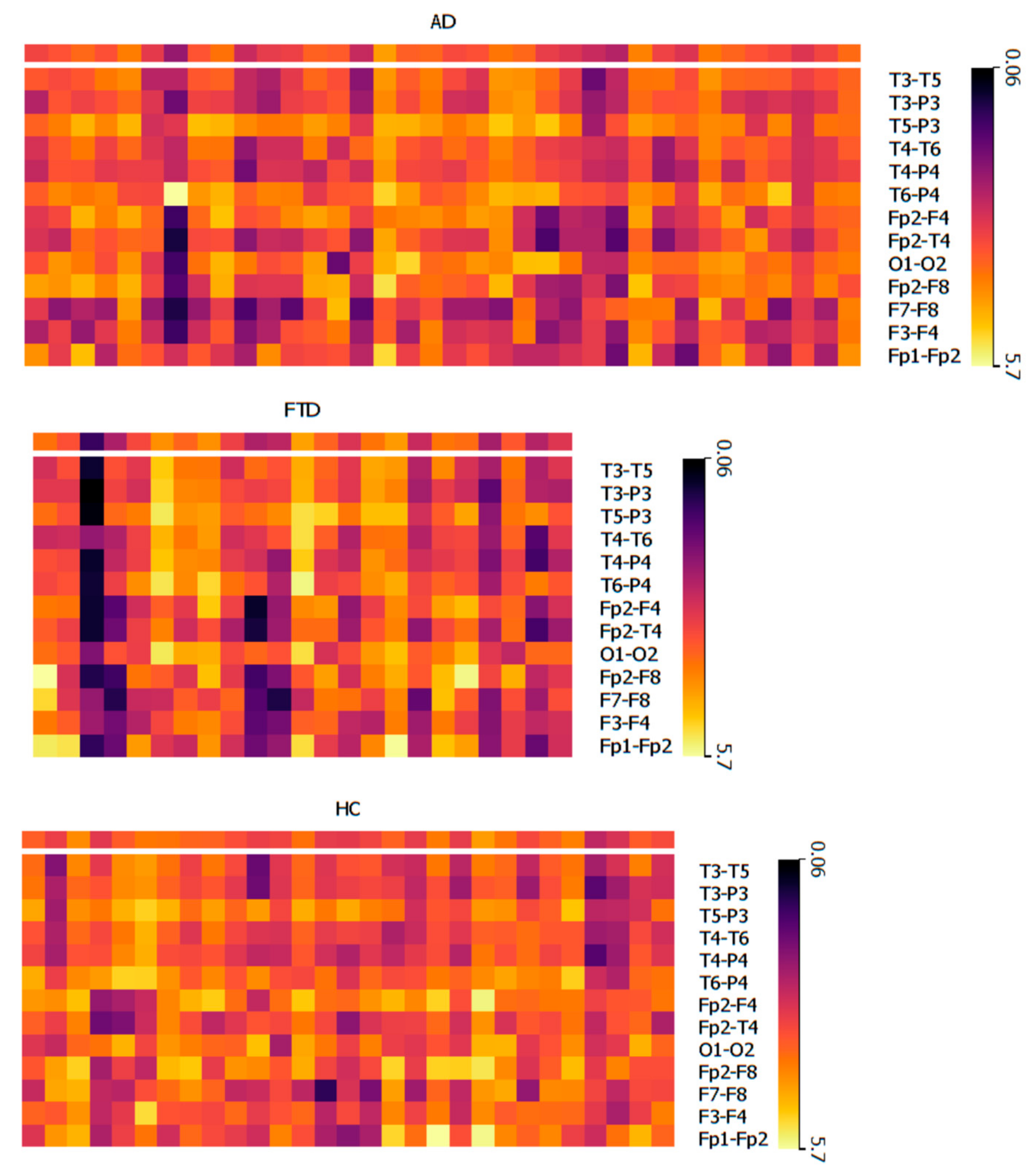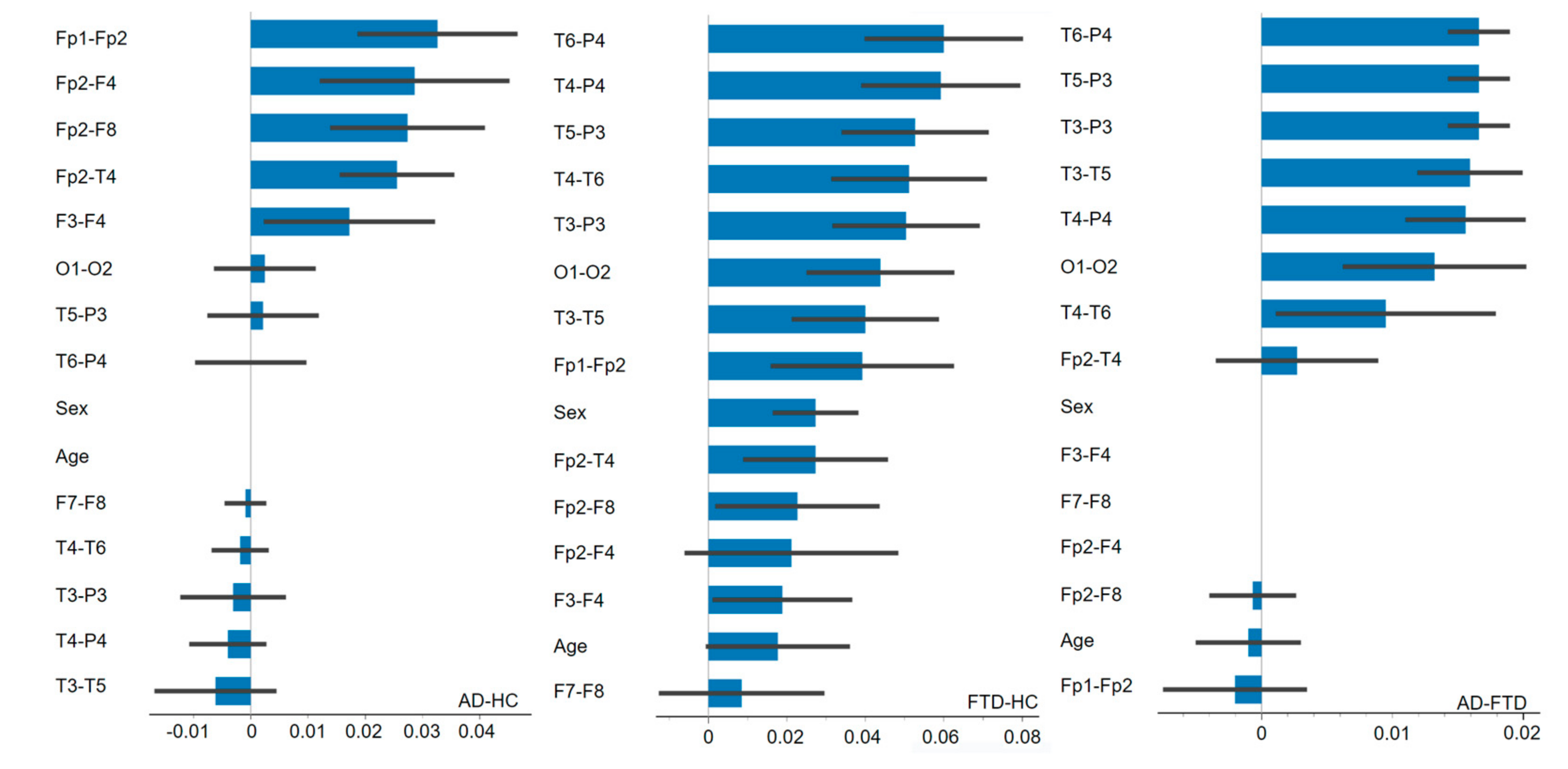Classification of Alzheimer’s Disease and Frontotemporal Dementia Using Electroencephalography to Quantify Communication between Electrode Pairs
Abstract
1. Introduction
2. Methods
2.1. Dataset
2.2. Computational Framework
2.3. Data Processing
2.4. Machine Learning
2.5. Analysis
3. Results
3.1. PHI Values
3.2. Classifications
4. Discussion
5. Conclusions
5.1. Summary
5.2. Contribution
5.3. Future Research
Author Contributions
Funding
Institutional Review Board Statement
Informed Consent Statement
Data Availability Statement
Acknowledgments
Conflicts of Interest
References
- Karantzoulis, S.; Galvin, J.E. Distinguishing Alzheimer’s disease from other major forms of dementia. Expert Rev. Neurother. 2011, 11, 1579–1591. [Google Scholar] [CrossRef] [PubMed]
- Miltiadous, A.; Tzimourta, K.D.; Giannakeas, N.; Tsipouras, M.G.; Afrantou, T.; Ioannidis, P.; Tzallas, A.T. Alzheimer’s disease and frontotemporal dementia: A robust classification method of EEG signals and a comparison of validation methods. Diagnostics 2021, 11, 1437. [Google Scholar] [CrossRef]
- Van Dyck, C.H.; Swanson, C.J.; Aisen, P.; Bateman, R.J.; Chen, C.; Gee, M.; Kanekiyo, M.; Li, D.; Reyderman, L.; Cohen, S.; et al. Lecanemab in early Alzheimer’s disease. N. Engl. J. Med. 2023, 388, 9–21. [Google Scholar] [CrossRef] [PubMed]
- Park, L.Q.; Harvey, D.; Johnson, J.; Farias, S.T. Deficits in everyday function differ in AD and FTD. Alzheimer Dis. Assoc. Disord. 2015, 29, 301–306. [Google Scholar] [CrossRef]
- Miltiadous, A.; Tzimourta, K.D.; Afrantou, T.; Ioannidis, P.; Grigoriadis, N.; Tsalikakis, D.G.; Angelidis, P.; Tsipouras, M.G.; Glavas, E.; Giannakeas, N.; et al. A dataset of scalp EEG recordings of Alzheimer’s disease, frontotemporal dementia and healthy subjects from routine EEG. Data 2023, 8, 95. [Google Scholar] [CrossRef]
- Zheng, H.; Xiong, X.; Zhang, X. Multi-Threshold Recurrence Rate Plot: A Novel Methodology for EEG Analysis in Alzheimer’s Disease and Frontotemporal Dementia. Brain Sci. 2024, 14, 565. [Google Scholar] [CrossRef]
- Lal, U.; Chikkankod, A.V.; Longo, L. A Comparative Study on Feature Extraction Techniques for the Discrimination of Frontotemporal Dementia and Alzheimer’s Disease with Electroencephalography in Resting-State Adults. Brain Sci. 2024, 14, 335. [Google Scholar] [CrossRef] [PubMed]
- Miltiadous, A.; Gionanidis, E.; Tzimourta, K.D.; Giannakeas, N.; Tzallas, A.T. DICE-net: A novel convolution-transformer architecture for Alzheimer detection in EEG signals. IEEE Access 2023, 11, 71840–71858. [Google Scholar] [CrossRef]
- Zheng, X.; Wang, B.; Liu, H.; Wu, W.; Sun, J.; Fang, W.; Jiang, R.; Hu, Y.; Jin, C.; Wei, X.; et al. Diagnosis of Alzheimer’s disease via resting-state EEG: Integration of spectrum, complexity, and synchronization signal features. Front. Aging Neurosci. 2023, 15, 1288295. [Google Scholar] [CrossRef]
- Nedeljković, M.; Pađin, P.; Nikolić, S. Low Dimensional EEG Classification for Alzheimer’s Disease Recognition. In Proceedings of the 2023 31st Telecommunications Forum, Belgrade, Serbia, 21 November 2023. [Google Scholar] [CrossRef]
- Ma, Y.; Bland, J.; Yoshikawa, G.; Fujinami, T. Quantifying Consciousness for Alzheimer’s Disease Diagnosis through Electroencephalogram Processing. In Proceedings of the 2024 8th International Conference on Medical and Health Informatics, Yokohama, Japan, 17–19 May 2024. [Google Scholar]
- Tomasello, L.; Carlucci, L.; Laganà, A.; Galletta, S.; Marinelli, C.V.; Raffaele, M.; Zoccolotti, P. Neuropsychological Evaluation and Quantitative EEG in Patients with Frontotemporal Dementia, Alzheimer’s Disease, and Mild Cognitive Impairment. Brain Sci. 2023, 13, 930. [Google Scholar] [CrossRef]
- Smailovic, U.; Jelic, V. Neurophysiological markers of Alzheimer’s disease: Quantitative EEG approach. Neurol. Ther. 2019, 8 (Suppl. 2), 37–55. [Google Scholar] [CrossRef] [PubMed]
- Wang, Z.; Liu, A.; Yu, J.; Wang, P.; Bi, Y.; Xue, S.; Zhang, J.; Guo, H.; Zhang, W. The effect of aperiodic components in distinguishing Alzheimer’s disease from frontotemporal dementia. Geroscience 2024, 46, 751–768. [Google Scholar] [CrossRef] [PubMed]
- Olğun, Y.; Aksoy Poyraz, C.; Bozluolçay, M.; Poyraz, B.Ç. Quantitative EEG in the Differential Diagnosis of Dementia Subtypes. J. Geriatr. Psychiatry Neurol. 2024, 37, 368–378. [Google Scholar] [CrossRef] [PubMed]
- Cassani, R.; Estarellas, M.; San-Martin, R.; Fraga, F.J.; Falk, T.H. Systematic review on resting-state EEG for Alzheimer’s disease diagnosis and progression assessment. Dis. Markers 2018, 2018, 5174815. [Google Scholar] [CrossRef] [PubMed]
- Tononi, G. An information integration theory of consciousness. BMC Neurosci. 2004, 5, 42. [Google Scholar] [CrossRef]
- Dong, K.; Zhang, D.; Wei, Q.; Wang, G.; Chen, X.; Zhang, L.; Liu, J. An integrated information theory index using multichannel EEG for evaluating various states of consciousness under anesthesia. Comput. Biol. Med. 2023, 153, 106480. [Google Scholar] [CrossRef]
- Kim, H.; Hudetz, A.G.; Lee, J.; Mashour, G.A.; Lee, U.; ReCCognition Study Group. Estimating the integrated information measure phi from high-density electroencephalography during states of consciousness in humans. Front. Hum. Neurosci. 2018, 12, 42. [Google Scholar] [CrossRef]
- Fox, M.D.; Snyder, A.Z.; Vincent, J.L.; Corbetta, M.; Van Essen, D.C.; Raichle, M.E. The human brain is intrinsically organized into dynamic, anticorrelated functional networks. Proc. Natl. Acad. Sci. USA 2005, 102, 9673–9678. [Google Scholar] [CrossRef]
- Zhou, J.; Greicius, M.D.; Gennatas, E.D.; Growdon, M.E.; Jang, J.Y.; Rabinovici, G.D.; Kramer, J.H.; Weiner, M.; Miller, B.L.; Seeley, W.W. Divergent network connectivity changes in behavioural variant frontotemporal dementia and Alzheimer’s disease. Brain 2010, 133, 1352–1367. [Google Scholar] [CrossRef]
- Zhou, J.; Seeley, W.W. Network dysfunction in Alzheimer’s disease and frontotemporal dementia: Implications for psychiatry. Biol. Psychiatry 2014, 75, 565–573. [Google Scholar] [CrossRef]
- Hafkemeijer, A.; van der Grond, J.; Rombouts, S.A. Imaging the default mode network in aging and dementia. Biochim. Biophys. Acta 2012, 1822, 431–441. [Google Scholar] [CrossRef] [PubMed]
- Alvarez, J.A.; Emory, E. Executive function and the frontal lobes: A meta-analytic review. Neuropsychol. Rev. 2006, 16, 17–42. [Google Scholar] [CrossRef] [PubMed]
- Coslett, H.B.; Schwartz, M.F. The parietal lobe and language. Handb. Clin. Neurol. 2018, 151, 365–375. [Google Scholar] [CrossRef]
- Spitsyna, G.; Warren, J.E.; Scott, S.K.; Turkheimer, F.E.; Wise, R.J. Converging language streams in the human temporal lobe. Neurosci. Res. 2006, 26, 7328–7336. [Google Scholar] [CrossRef] [PubMed]
- Nardone, R.; Sebastianelli, L.; Versace, V.; Saltuari, L.; Lochner, P.; Frey, V.; Golaszewski, S.; Brigo, F.; Trinka, E.; Höller, Y. Usefulness of EEG techniques in distinguishing frontotemporal dementia from Alzheimer’s disease and other dementias. Dis. Markers 2018, 2018, 6581490. [Google Scholar] [CrossRef] [PubMed]
- Dottori, M.; Sedeño, L.; Martorell Caro, M.; Alifano, F.; Hesse, E.; Mikulan, E.; García, A.M.; Ruiz-Tagle, A.; Lillo, P.; Slachevsky, A.; et al. Towards affordable biomarkers of frontotemporal dementia: A classification study via network’s information sharing. Sci. Rep. 2017, 7, 3822. [Google Scholar] [CrossRef]
- Filippi, M.; Agosta, F.; Scola, E.; Canu, E.; Magnani, G.; Marcone, A.; Valsasina, P.; Caso, F.; Copetti, M.; Comi, G.; et al. Functional network connectivity in the behavioral variant of frontotemporal dementia. Cortex 2013, 49, 2389–2401. [Google Scholar] [CrossRef]
- Seeley, W.W.; Crawford, R.; Rascovsky, K.; Kramer, J.H.; Weiner, M.; Miller, B.L.; Gorno-Tempini, M.L. Frontal paralimbic network atrophy in very mild behavioral variant frontotemporal dementia. Arch. Neurol. 2008, 65, 249–255. [Google Scholar] [CrossRef]



| Group | N | Males (N) | Age (Mean ± SD) | MMSE 1 (Mean ± SD) |
|---|---|---|---|---|
| AD 2 | 36 | 12 | 66.39 ± 7.89 | 17.75 ± 4.50 |
| FTD 3 | 23 | 14 | 63.60 ± 8.20 | 22.17 ± 8.22 |
| HC 4 | 29 | 18 | 67.90 ± 5.40 | 30 |
| Model | Hyperparameter | Classification Accuracy | F1 Score |
|---|---|---|---|
| SVM 1 | sigmoid kernel | 0.860 | 0.860 |
| MLP 2 | 1 hidden layer, 10 neurons | 0.770 | 0.760 |
| KNN 3 | k = 21 | 0.690 | 0.690 |
| Electrode Pair | AD Mean (SD) 1 | FTD Mean (SD) 2 | HC Mean (SD) 3 |
|---|---|---|---|
| Fp1-Fp2 | 3.25 (0.89) | 3.29 (1.44) | 3.64 (0.97) |
| Fp2-F4 | 3.54 (0.94) | 3.17 (1.26) | 3.97 (0.84) |
| F3-F4 | 2.96 (0.78) | 2.97 (0.89) | 3.50 (0.65) |
| Fp2-F8 | 3.65 (0.95) | 3.43 (1.38) | 3.92 (0.90) |
| Fp2-T4 | 2.99 (0.89) | 2.78 (1.10) | 3.20 (0.71) |
| F7-F8 | 2.81 (1.05) | 2.95 (1.20) | 3.25 (0.98) |
| T5-P3 | 4.06 (0.68) | 3.92 (1.11) | 3.90 (0.78) |
| T3-P3 | 3.18 (0.67) | 3.19 (1.10) | 3.14 (0.76) |
| O1-O2 | 3.81 (0.87) | 3.81 (0.87) | 3.71 (0.73) |
| T3-T5 | 3.44 (0.70) | 3.39 (0.99) | 3.33 (0.76) |
| T4-T6 | 3.35 (0.60) | 3.22 (0.94) | 3.28 (0.60) |
| T4-P4 | 3.11 (0.55) | 3.08 (1.10) | 3.14 (0.68) |
| T6-P4 | 4.04 (0.64) | 3.66 (1.07) | 3.92 (0.67) |
| Features | Train Time (s) | Test Time (s) | Classification Accuracy | F1 | Precision | Recall | Specificity | |
|---|---|---|---|---|---|---|---|---|
| AD-HC 1 | 15 | 0.376 | 0.195 | 0.769 | 0.754 | 0.814 | 0.769 | 0.720 |
| FTD-HC 2 | 15 | 0.253 | 0.162 | 0.904 | 0.902 | 0.918 | 0.904 | 0.879 |
| AD-FTD 3 | 15 | 0.357 | 0.174 | 0.915 | 0.913 | 0.926 | 0.915 | 0.867 |
| AD-FTD | 8 | 0.206 | 0.089 | 0.966 | 0.966 | 0.968 | 0.966 | 0.947 |
| Classification | Feature | Mean Decrease in Accuracy (Mean ± SD) |
|---|---|---|
| AD-HC | Fp1-Fp2 | 0.033 ± 0.014 |
| Fp2-F4 | 0.029 ± 0.017 | |
| Fp2-F8 | 0.027 ± 0.014 | |
| Fp2-T4 | 0.026 ± 0.010 | |
| F3-F4 | 0.017 ± 0.015 | |
| FTD-HC | T6-P4 | 0.060 ± 0.020 |
| T4-P4 | 0.059 ± 0.020 | |
| T5-P3 | 0.053 ± 0.019 | |
| T4-T6 | 0.051 ± 0.020 | |
| T3-P3 | 0.050 ± 0.019 | |
| AD-FTD | T6-P4 | 0.017 ± 0.002 |
| T5-P3 | 0.017 ± 0.002 | |
| T3-P3 | 0.017 ± 0.002 | |
| T3-T5 | 0.016 ± 0.004 | |
| T4-P4 | 0.016 ± 0.004 |
| Study | Comparability 1 | AD-HC | FTD-HC | AD-FTD |
|---|---|---|---|---|
| Miltiadous et al. [5] 2 | YES | 0.770 (RF 3) | 0.731 (MLP) | - |
| Zheng et al. [6] | YES | 0.877 (SVM) | 0.827 (SVM) | 0.729 (SVM) |
| Lai et al. [7] | NO | 0.910 (KNN) | 0.930 (KNN) | 0.910 (KNN) |
| Miltiadous et al. [8] | YES | 0.833 (DICE 4) | 0.750 (DICE) | - |
| Zheng et al. [9] | YES | 0.959 (RF) | - | - |
| Nedeljković et al. [10] | YES | 0.776 (RF) | - | - |
| Ma et al. [11] | YES | 0.862 (SVM) | - | - |
| Current study 1 | YES | 0.769 (SVM) | 0.904 (SVM) | 0.915 (SVM) |
| Current study 2 | YES | - | - | 0.966 (SVM) |
Disclaimer/Publisher’s Note: The statements, opinions and data contained in all publications are solely those of the individual author(s) and contributor(s) and not of MDPI and/or the editor(s). MDPI and/or the editor(s) disclaim responsibility for any injury to people or property resulting from any ideas, methods, instructions or products referred to in the content. |
© 2024 by the authors. Licensee MDPI, Basel, Switzerland. This article is an open access article distributed under the terms and conditions of the Creative Commons Attribution (CC BY) license (https://creativecommons.org/licenses/by/4.0/).
Share and Cite
Ma, Y.; Bland, J.K.S.; Fujinami, T. Classification of Alzheimer’s Disease and Frontotemporal Dementia Using Electroencephalography to Quantify Communication between Electrode Pairs. Diagnostics 2024, 14, 2189. https://doi.org/10.3390/diagnostics14192189
Ma Y, Bland JKS, Fujinami T. Classification of Alzheimer’s Disease and Frontotemporal Dementia Using Electroencephalography to Quantify Communication between Electrode Pairs. Diagnostics. 2024; 14(19):2189. https://doi.org/10.3390/diagnostics14192189
Chicago/Turabian StyleMa, Yuan, Jeffrey Keith Spaneas Bland, and Tsutomu Fujinami. 2024. "Classification of Alzheimer’s Disease and Frontotemporal Dementia Using Electroencephalography to Quantify Communication between Electrode Pairs" Diagnostics 14, no. 19: 2189. https://doi.org/10.3390/diagnostics14192189
APA StyleMa, Y., Bland, J. K. S., & Fujinami, T. (2024). Classification of Alzheimer’s Disease and Frontotemporal Dementia Using Electroencephalography to Quantify Communication between Electrode Pairs. Diagnostics, 14(19), 2189. https://doi.org/10.3390/diagnostics14192189






